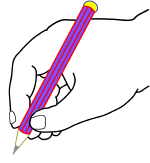Hand Position for Playing Piano
The Strong Muscles
The muscles on the underside of the arm and hand are your strong muscles. These are the muscles that move your hand and arm and fingers down.
These are the muscles that we want to use when we play piano. In other words, your fingers should be curved down when you play.
The Weak Muscles
The weak muscles of your arms and hand are the muscles on top of the arm and hand. These are the muscles that move your arm and hand and fingers up. These muscles are not strong enough to take much pressure.
If you put pressure on your fingers from the bottom with fingers extended or flat over a substantial period of time, your fingers will get hyperextended or curved up or bent up. This is permanent bone damage.
Test Your Fingers
Open your hand and extend your fingers. When your hand is extended, normally your fingers should be straight. This is what is normal and correct. If they are curving up, you have permanent bone damage. Hyperextended fingers
Hyperextended fingersImage source: http://kingdomofstyle.typepad.co.uk/.a/6a00d8341c2f0953ef017c322238ca970b-popup
You can get this permanent bone damage from using flat fingers and putting pressure on the pad of your fingers from below, rather than curving your fingers down and using the tips or the forepart of the pad of your fingers.
Routine Usage
Also, learn to pick things up routinely with the fingers curved down and using the tips or forepart of the pad of your fingers, rather than with the fingers flat and using the pads of your fingers. Your nails will need to be very short, so that they don't interfere with the finger position. Long nails interfere with good hand position.And, by the way, how do you hold a pencil?
Is your index finger bent down at the first joint?

Image source: www.getreadyforschool.com
Or is the first joint of your index finger collapsed?

Image source: www.babynaturopathics.com

